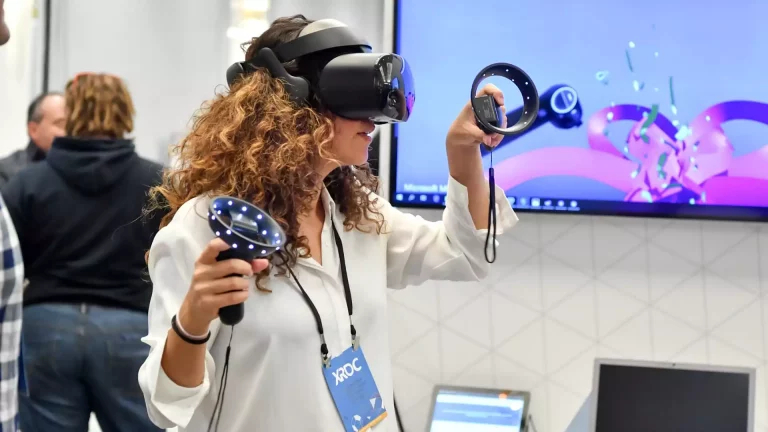
As the march of technology continues, we’ve seen VR leap forward. Institutions and individuals can use the technology in ways that range from education to gaming. Another area where VR starting to show its potential is HR functions like professional hiring and new-employee training.
This trend is related to a larger movement where companies, lured by the potential to increase productivity and lower turnover rates, are investing in a range of technologies. VR project management in human resources, though challenging, can bring several benefits.
How is it doing that? Here are just five ways…
1. Reusable Experiences
Many repetitive and often mundane tasks are involved in the hiring process. When looking for candidates, you need to ensure that they’ll be a good fit for the business. You’ll have to take them through a series of tests or interviews and background checks to ensure that they won’t steal anything or otherwise be a threat to the company.
All these steps might sound time-consuming, but you can use one job simulation multiple times without compromising quality. The simulation of the workplace and typical tasks is portable, and you can take it on the go for repeated use.
The re-usability element means having multiple simulations of potential employees in one place, allowing you to find the best match for your company without wasting time. In some cases, you might even be able to do a trial run with a candidate before making a final decision.
A new hire’s experience and understanding of the product or service can hugely impact their performance and productivity. It can profoundly affect candidates and make them more interested in the role they’re about to take on.
2. Employee Confidence
One area where VR has proven highly beneficial is employee training. Many companies are doing their best to ensure that their employees have adequate training to do their jobs. However, training becomes difficult as it’s challenging to replicate a work environment at a company’s training facility.
With VR’s immersive experiences, you can take a candidate’s existing knowledge and skills and let them experience every aspect of the company they’re interviewing with. This kind of immersion can help close the gap between what potential employees know and how they react to all the new things they’ll face when they start work.
VR training modules can help train employees on what to expect, act, and do in a particular business. This can help improve employee confidence and reduce turnover rates by making employees feel ready for challenges.
3. Personalized Training
Job training is essential for settling into a new workplace, but it can also be long and drawn out. You’ll have to have employees spend time at the training facility with other employees or even external trainers to learn about their trade and how things work.
While this is necessary due to the level of information covered in training, it can lead to productivity loss. Instead, most new hires would rather work on projects relevant to their job than attend lectures or sit through video presentations. VR can solve this issue by making your training modules interactive and hands-on.
VR can help uncover relevant information by showing candidates their future roles within their contexts. This gives them a sense of ownership over their position, which helps motivate them and improve morale. You can skip the long, drawn-out lectures and presentations and put your new hires at the center of their training experience.
It’s a much better way for them to learn about their job than just by reading about it or being told about it in a classroom environment.
4. Demonstrating Company Culture
Your organization’s culture is vital, but finding ways to communicate that culture to new hires effectively is not always straightforward. It’s hard to determine how well a candidate will fit into their new role.
However, VR technology can make this easier for you. What if you could give them the whole VR experience and let them explore a business through the eyes of your current employees?
Many companies now have interactive interviewing rooms that allow potential employees to interact with the company and feel its culture firsthand. In some cases, you can even go further and enable candidates to experience your company’s culture before starting work.
By projecting certain aspects of the corporate environment into their VR headsets, you can put candidates in a real-life, immersive environment. VR can significantly improve a candidate’s experience, allowing them to put themselves in your shoes before committing for the long term through a simulation.
5. Cost-Effective Training
When it comes to training employees, many companies face budget constraints. For some businesses, employee training can end up being incredibly expensive.
Companies need to make sure that they’re spending valuable time and money on the right opportunities. This helps make sure that their new hires are successful and productive.
VR lets you get the most out of your human resources department by training candidates faster and more efficiently. If you can conduct quality interviews through simulations, you can save a lot of financial resources by eliminating the need for personal interviews with applicants or third-party assessments.
VR will allow you to get closer to the quality candidates your business needs without spending as much money on training. Eventually, you want your hiring practices to have a positive return on investment.
VR and the Hiring Process
Given VR’s advancements over the past few years, it’s now easier than ever for businesses to use it to make smarter decisions on whom to hire next.
By implementing virtual and simulated experiences, VR can also make corporate culture more accessible to new candidates, thus setting them up to do their best work.
 Romy Toma-Catauta is a marketer and writer who covers emerging tech and design.
Romy Toma-Catauta is a marketer and writer who covers emerging tech and design.






